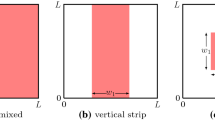Abstract
Models for species dispersal make various simplifications to facilitate analysis, such as ignoring spatial correlations or assuming equal probability of colonization among all sites within a dispersal neighborhood. Here we introduce a variation of the basic contact process (BCP) which allows us to separate the number of offspring produced from the neighborhood size, which are confounded in the original BCP. We then use classical results arising from probability models involving placing balls in urns to study our modified BCP, obtaining bounds for the critical value of the survival probability needed for the population to persist. We also use the probability urn calculations with a local-dispersal mean-field approximation to estimate equilibrium population density. These methods are able to include features such as unequal dispersal probabilities to different sites in the neighborhood, e.g., as would arise when dispersers have a fixed rate of mortality per distance traveled from the parent site. We also show how urn models allow one to generalize these results to two species competing for space.






Similar content being viewed by others
References
Allen LJ (2003) An introduction to stochastic processes with applications to biology. Pearson Prentice Hall, Upper Saddle River
Bolker B, Pacala S (1999) Spatial moment equations for plant competition: understanding spatial strategies and the advantages of short dispersal. Am Nat 153(6):575–602
Caswell H, Cohen J (1991) Communities in patchy environments: a model of disturbance, competition, and heterogeneity. Ecol Stud 86:97–122
de Vries G, Hillen T, Lewis M, Müller J, Schönfisch B (2006) A course in mathematical biology. SIAM, Philadelphia
Durrett R, Levin S (1994a) The importance of being discrete (and spatial). Theor Popul Biol 46(3):363–394
Durrett R, Levin S (1994b) Stochastic spatial models: a user’s guide to ecological applications. Philos Trans R Soc B (343):329–350
Durrett R, Levin S (1998) Spatial aspects of interspecific competition. Theor Popul Biol 53(1):30–43
Hanski I (1994) Patch-occupancy dynamics in fragmented landscapes. Trends Ecol Evol 9(4):131–135
Harris T (1974) Contact interactions on a lattice. Ann Probab 2(6):969–988
Hastings A (1991) Structured models of metapopulation dynamics. Biol J Linn Soc 42(1):57–71
Hernández-Suárez C, Castillo-Chavez C (2000) Urn models and vaccine efficacy estimation. Stat Med 19(6):827–835
Hernández-Suárez C, Mendoza-Cano O (2009) Applications of occupancy urn models to epidemiology. Math Bios Eng 6(3):509–520
Hiebeler D (1997) Stochastic spatial models: from simulations to mean field and local structure approximations. J Theor Biol 187(3):307–319
Johnson N, Kotz S (1977) Urn models and their application: an approach to modern discrete probability theory. Wiley, Cambridge
Johnson N, Kotz S, Kemp A (1992) Univariate discrete distributions. Wiley, New York
Kareiva P (1994) Space: the final frontier for ecological research. Ecology 75:1
Klausmeier C, Tilman D (2002) Spatial models of competition. In: Sommer U, Worm B (eds) Competition and coexistence. Springer, New York, pp 43–78
Levin S and Durrett R (1996) From individuals to epidemics. Phil Trans, Biol Sci 351:1615–1621
Matsuda H, Ogita N, Sasaki A, Sato, K (1992) Statistical mechanics of population. Prog Theor Phys 88(6):1035–1049
Nee S, May R (1992) Dynamics of metapopulations: habitat destruction and competitive coexistence. J Anim Ecol 61:37–40
Pacala S (1986) Neighborhood models of plant population dynamics. 2. Multi-species models of annuals. Theor Popul Biol 29(2):262–292
Ross SM (2007) Introduction to probability models, 9th ed. Academic, New York
Tilman D (1994) Competition and biodiversity in spatially structured habitats. Ecology 75(1):2–16
von Mises R (1963) Selected papers of R. Von Mises. American Mathematical Society, Providence
Waser PM (1985) Does competition drive dispersal? Ecology 66(4):1170–1175
Acknowledgements
This material is based upon work supported by the National Science Foundation under grant no. DMS-0718786 to D. H. Thanks to the several anonymous reviewers for their input and suggestions.
Author information
Authors and Affiliations
Corresponding author
Appendix
Appendix
Let M be the total number of sites available. Let x 1 and x 2 be the fraction of occupied sites by species 1 and 2, respectively. Let γ 1 and γ 2 be the respective probabilities of survival per unit of time, and ϕ the probability that a site newly occupied by both species simultaneously, will be occupied by species 1, regardless of the amount of each type. Before reproduction, deaths occur and the expected fraction of occupied sites is now x 1 γ 1 and x 2 γ 2. In the equilibria, the fraction of deaths of each species has to be replaced at the next unit of time by the newly occupied sites of each species. That is, the expected fraction of newly occupied sites at the next unit of time must be equal to x 1 (1 − γ 1) and x 2 (1 − γ 2) for each species. These newborns can only be produced by those that survived.
Let α 1 be the fraction of empty sites that will receive a seed from species 1. Let α 2 be the equivalent for species 2. The fraction of newly occupied sites by species 1 is:
Now, the probability that a seed will fall in an empty site is θ = 1 − x 1 γ 1 − x 2 γ 2. Using Eq. 9 with b = Mx 1 γ 1 and N = M, we see that the Mx 1 γ 1 survivors will produce the same number of seeds that will fall on a fraction
of the total sites on the grid. Many of those sites are already occupied by survivors of species 1 and 2 in the previous unit of time (and we assume cannot be displaced by the newborns). From this fraction, a fraction θ will fall in an empty site. Thus, we arrive to an expression for α 1, the fraction of empty sites that will receive a seed from species 1:
We can obtain α 2 using a similar argument. Combining this result with Eq. 14, we arrive to the following equalities:
Rights and permissions
About this article
Cite this article
Hernandez-Suarez, C.M., Hiebeler, D. Modeling species dispersal with occupancy urn models. Theor Ecol 5, 555–565 (2012). https://doi.org/10.1007/s12080-011-0147-8
Received:
Accepted:
Published:
Issue Date:
DOI: https://doi.org/10.1007/s12080-011-0147-8




